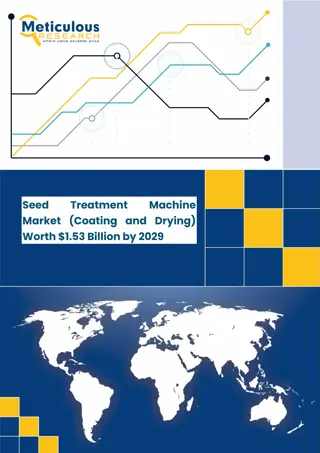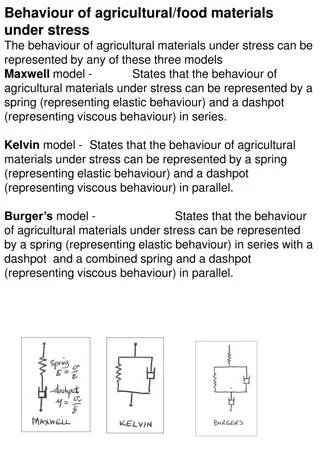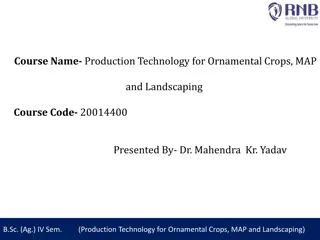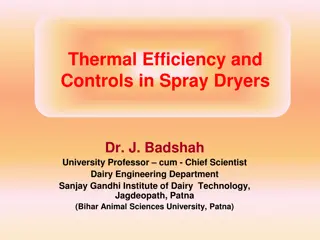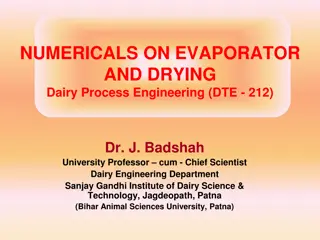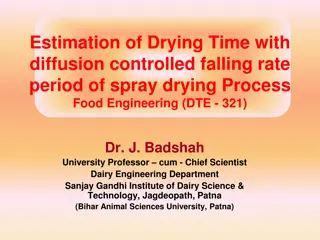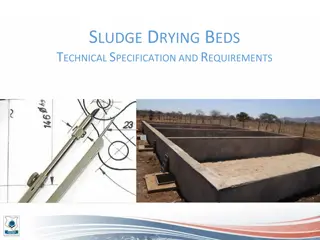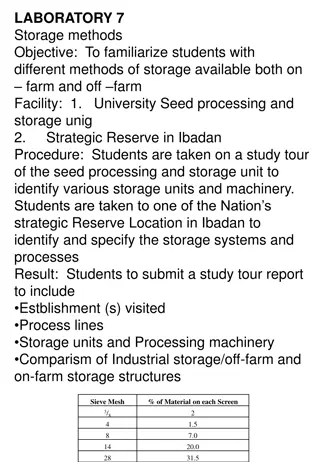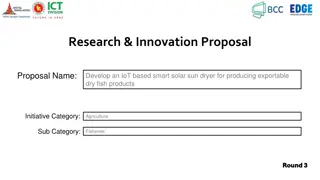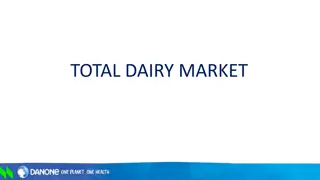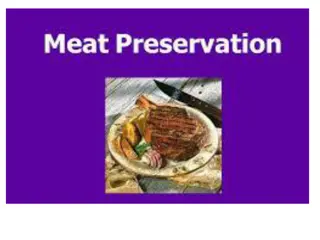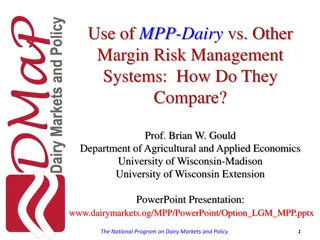Drum Drying and Analysis in Dairy Engineering
Drum drying involves drying thin films on the surface of rotating steam-heated drums, with various types of drum dryers available. Factors affecting capacity and operation include milk feed temperature, concentration, drum speed, and steam pressure. The process requires careful monitoring to avoid issues like scorching and low solubility in the final product.
Download Presentation

Please find below an Image/Link to download the presentation.
The content on the website is provided AS IS for your information and personal use only. It may not be sold, licensed, or shared on other websites without obtaining consent from the author.If you encounter any issues during the download, it is possible that the publisher has removed the file from their server.
You are allowed to download the files provided on this website for personal or commercial use, subject to the condition that they are used lawfully. All files are the property of their respective owners.
The content on the website is provided AS IS for your information and personal use only. It may not be sold, licensed, or shared on other websites without obtaining consent from the author.
E N D
Presentation Transcript
Drum Drying & Analysis Dr. J. Badshah University Professor cum - Chief Scientist Dairy Engineering Department Sanjay Gandhi Institute of Dairy Technology, Jagdeopath, Patna (Bihar Animal Sciences University, Patna)
Drum Drying Thin film on the outside surface of rotating steam heated drum causes drying and rotation enhances the agitation and high heat transfer coefficients during drying. It is known as film drying or Roller Drying. The residence time of heating and evaporation is from feed point to the point of doctor blade, which scraped the dried film from the drum. It took about three quarter of a complete rotation on the drum surface Above the surface of film either atmospheric pressure or vacuum is maintained. The ratio of steam consumption to water evaporation is from 1.2 to 1.6 : 1 in drum drying under atmospheric pressure Scorched Flavour in Powder and lower solubility of about 85 % are the disadvantages due to high protein denaturation in drum drying under atmospheric pressure.
Types of Drum Dryers Number of Drums: (a)Single drum, (b) double drum, or twin drum Pressure surrounding the film of feed: (a) Atmospheric (b) Vacuum Feeding Arrangements: (a) Nip Feed , (b) Splash Feed ( c ) Dip Feed, and (d) Roller Feed MOC : (a) Alloy Steel (b) Stainless steel and ( c) Chrome or Nickel plate steel
Evaporation Rate and Drying Time Rate of evaporation dw/dt = U A T/ Hv T = (ts tb) Mean temperature difference between the roller surface (ts) and the product boiling temperature (tb) in C Hv= Latent heat of vaporization at tbi.e. boiling point of milk 1/U = 1/hs+ x/k +1/hp+ 1/(hc+ hr +he), where hs= Eqivalent film coefficient of steam, Kcal/h-m2 C=4000 X = Film Thickness, m K Thermal conductivity of metal, Kcal/h-m- C hp= Equivalent film coefficient of product, Kcal/h-m2 C hc=Convection Coefficient, Kcal/h-m2 C = 5.0 hr= Radiation coefficient, Kcal/ h-m2- C=7.5 he= Evaporation film coefficient, Kcal/h-m2 C= 250
Factors Affecting the Capacity and Operation of Drum Dryer The drying capacity varie from 5 to 50 kg of dry product per m2 and is affected by following factors: Milk Feed temperature, concentration (desirable 18-25 % TS) and level of milk Avoid uneven and broken sheet of drying materials on the drum Drum gap in double drum dryer Drum speed, Roller alignment Steam pressure and temperature not too high and drum speed not too low Condensate removal High moisture of the product may be due to low temperature, thick film, high solid and high rpm of the drum.
Factors Affecting the Capacity and Operation of Drum Dryer Drums must be properly aligned and have identical characteristics of speed, heat transfer and wear etc. The spacing between drums is about 0.5 to 1.0 mm. Knives must be reground regularly after every 100 hour for uniform sharpness Drums must be kept smooth Drums must be vented of air for better heat utilization Condensate must be continuously duscharged from the drum Accurate control of the feed device Preheating of the milk is advantageous but the temperature must not exceed 71 C Slightly acidic milk yields a powder of dark colour and poor flavour The dried product must be scraped off after to 7/8 revolution of the drum so that solid contact to meta is less than 3 seconds to avoid the scorched flavour, burning and brown colour with poor quality
Total Drying Time including diffusion controlled falling rate period Total drying time in three stage of spray dying rates: Constant Rate Period First Falling rate period without diffusion controlled but capillary movement controlled Second Falling Rate Period with diffusion controlled period Total Drying time t = tc+ tf1+ tf2 tc= HL(wo- wc)/ h A ( TA Ts) tc= HL(wo- wc)/ (K/R) 4 R2( TA Ts) tf1 = wc/ Ncln (wc/ w1) tf2 = R2/ 2D ln [6/ 2(w1 we)/( w we)]
Vacuum Drum Dryers- Single and double Roller types




